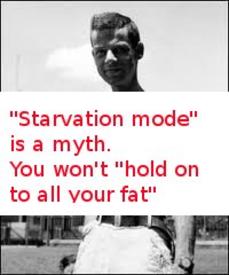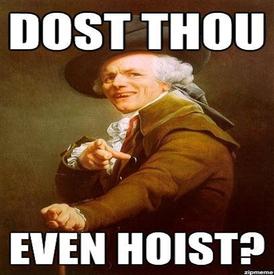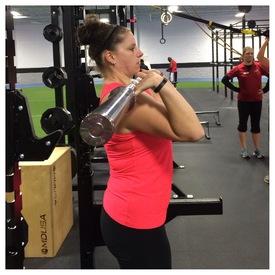Very interesting research on weight loss rate
Replies
-
Maintaining muscle mass with weight loss negates much of if not all of the decrease in metabolism that usually follows weight loss...
You'd have to gain about a pound of muscle for every three pounds of fat lost to keep RMR the same. Even if you did that, your exercise calories would still go down because that is mostly affected by overall mass.
That depends. If you lose weight while exercising, often you get into good shape and can burn far more calories by exercising longer and harder.
True, if you exercise more or with higher intensity, then you can keep up your earned calories. For example, since I've shaved a couple of minutes from my easy pace, I can burn more calories per hour running than I did 15 lbs ago. However, if I ran at the same pace as before, I'd burn less per hour. I'm always burning less per mile than I was at the beginning.0 -
bumping so I can study when I have a little more time. Thanks!0
-
Bump. Want to keep this fresh so I can report back with my Pennington results. Java is not working on my old Mac. Grrr...0
-
Maintaining muscle mass with weight loss negates much of if not all of the decrease in metabolism that usually follows weight loss...
That would depend on how much weight is lost, wouldn't it? I don't think muscle can counteract a huge weight loss when it comes to metabolism. I mean if you go from 300 lbs to 150 lbs your metabolism is going to be slower even if you have a lot of muscle.0 -
Here is a fascinating online calculator that illustrates the improved weight loss prediction models from this research.
http://www.pbrc.edu/research-and-faculty/calculators/weight-loss-predictor/
I'm not sure I understand where they are getting the "current intake" from, but I put the deficit so that it reflected what the number of calories I am currently averaging per day and it says I'll lose 21 lbs in the next year. I've been eating this amount for about a year and I'm maintaining. :huh:
The "current intake" shown is more than 1000 calories over my BMR. If I ate that much I'd gain weight quickly.0 -
They have - http://bwsimulator.niddk.nih.gov/ you may have to set a few things to Manual or select "Advanced settings" but it can handle your input of % body fat.Great tool but i hate how all of these tools assume that because I'm 185 pounds and that I'm 5'6" therefore I'm obese even though i know my body fat is 22.7%. You would think the scientific community would at least put some time and effort into being better predictors of this.
The online tools are simplified for online interactive use and public consumption. The work done by Hall is available as a model for you to run yourself in its full glory.0 -
Gotta read this later. Bump0
-
Bump0
-
It's their TDEE estimate. The RMR element is from the Livingston-Kohlstadt model as described at http://www.pbrc.edu/research-and-faculty/calculators/weight-loss-predictor/about/I'm not sure I understand where they are getting the "current intake" from
"EE was modeled as the sum of resting metabolic rate (RMR), voluntary physical activity (PA), dietary induced thermogenesis (DIT), and spontaneous physical activity (SPA)" - their estimates of these elements are also outlined at the above ref0 -
Additionally, since the body naturally slows metabolism as pounds are lost, the dieter must recalibrate their caloric needs every so often to account for their reduced RMR. If not, their predicted weight loss will dwindle and they will hit the dreaded plateau.
Of course as you get smaller you will need to keep adjusting your intake downward because your body takes less calories overall.
That's one thing I don't like about that calculator, too. It assumes you can't change your eating over time? I think it makes a lot more sense to just readjust your goals/plan as you shrink than to try to map out diminishing returns from keeping a steady intake for a year or more while losing weight.0 -
This.Maintaining muscle mass with weight loss negates much of if not all of the decrease in metabolism that usually follows weight loss...
http://www.korr.com/solutions/files/faq-4-3.pdf
Even on a VLCD, weight training subjects preserved ALL lean body mass, and INCREASED their BMR. Cardio group lost a significant amount of muscle mass and lowered BMR.0 -
It's their TDEE estimate. The RMR element is from the Livingston-Kohlstadt model as described at http://www.pbrc.edu/research-and-faculty/calculators/weight-loss-predictor/about/I'm not sure I understand where they are getting the "current intake" from
"EE was modeled as the sum of resting metabolic rate (RMR), voluntary physical activity (PA), dietary induced thermogenesis (DIT), and spontaneous physical activity (SPA)" - their estimates of these elements are also outlined at the above ref
I went back to see if I missed a physical activity setting, but still didn't see one. I guess they are assuming I burn a lot more calories than I do.0 -
bump..thanks0
-
Mine was pretty ridiculous too--something like 2700(!). Now I like my food, but I'm pretty sure I'd be gaining weight on that amount.
It's their TDEE estimate. The RMR element is from the Livingston-Kohlstadt model as described at http://www.pbrc.edu/research-and-faculty/calculators/weight-loss-predictor/about/I'm not sure I understand where they are getting the "current intake" from
"EE was modeled as the sum of resting metabolic rate (RMR), voluntary physical activity (PA), dietary induced thermogenesis (DIT), and spontaneous physical activity (SPA)" - their estimates of these elements are also outlined at the above ref
I went back to see if I missed a physical activity setting, but still didn't see one. I guess they are assuming I burn a lot more calories than I do.0 -
Actually seems about right because I am eating at a 1010 calories deficit regardless of exercise and it says I should be at goal weight in 6 months with an average lass of 6lbs per month which is about what I am at. Interesting!0
-
Way interesting.
Thanks!!0 -
there isn't one, you're right. They are using general population numbers I guess -I went back to see if I missed a physical activity setting, but still didn't see one. I guess they are assuming I burn a lot more calories than I do.
" PA is modeled by a term that is directly proportional to weight:
PA = mW "
so it assumes your activity cost in calories is proportional to your weight. Makes it simpler to use I guess.
For me, the simpler Pennington tool assumes I use more calories than Hall's calculator, but then puts me on a bigger deficit to hit the same goal - so I end up being advised the same calories to eat in each case. Which seems a bit odd to be honest, I was expecting the deficits to be similar so I'll have to lie down in a dark room and think about it.0 -
Bump0
-
bump0
-
bump0
-
bump....bumpitybumpbump........bump,bump0
-
bump0
-
This.Maintaining muscle mass with weight loss negates much of if not all of the decrease in metabolism that usually follows weight loss...
http://www.korr.com/solutions/files/faq-4-3.pdf
Even on a VLCD, weight training subjects preserved ALL lean body mass, and INCREASED their BMR. Cardio group lost a significant amount of muscle mass and lowered BMR.
Interestiing! Great point. Kinda makes sense though.0 -
the weight i lost in the last 47 days is off thier charts...i cant reproduce my results on thier calculator....i must be doing something the creators of the chart thought was impossible.....for thier chart to reflect my current weight i would have to have been calorie reduced by 1500 (the max the chart allows) for 7 months...not 1.5 months like my results prove possible0
-
Bump0
-
bump0
-
dump
(...'bump' is played out.)0 -
This.Maintaining muscle mass with weight loss negates much of if not all of the decrease in metabolism that usually follows weight loss...
http://www.korr.com/solutions/files/faq-4-3.pdf
Even on a VLCD, weight training subjects preserved ALL lean body mass, and INCREASED their BMR. Cardio group lost a significant amount of muscle mass and lowered BMR.
so you're saying that it is best to strength train more than do cardio in order to maintain lean body mass on a VLCD...although I don't prefer a VLCD this arouses my interest...I'm curious to read what do others people think, can someone break this down on here? I'm going to spend some time analyzing this more.
The initial article goes back to what they said about the hunter and gatherer lifestyle where they do low key walking for hours of the day, spontaneous sprints, occasional heavy lifting...See Marks Daily Primal diet...
Also...I see what others are saying that the TDEE doesn't make sense...the question that I think most people are wondering is how does this calculator know how much I burn doing spontaneous activities? It does make sense as on my workout days I usually get to 2220-2300 and if I workout hard or on a busy day then I'm up to 2500/2600, but then what if someone doesn't workout at all or on some days?. But with a higher or extremely lower active day that number is not going to go to reflect more or less activity so that's confusing.
The calculator is neat though, but for me it doesn't dismiss the myths around netting your BMR and not eating below 1200 calories. Although I don't support a 1200 calorie diet it's the netting your BMR that I' scratching my head over.0 -
Bump to read it later0
-
That seems to be a common finding, there's usually some benefit to maintaining LBM of exercise, just like there is with high protein, but resistance training seems to do best.so you're saying that it is best to strength train more than do cardio in order to maintain lean body mass
Doing cardio and "eating back the calories" would appear to be of practically no value to weight loss.0
This discussion has been closed.
Categories
- All Categories
- 1.4M Health, Wellness and Goals
- 394.9K Introduce Yourself
- 44K Getting Started
- 260.6K Health and Weight Loss
- 176.2K Food and Nutrition
- 47.5K Recipes
- 232.7K Fitness and Exercise
- 444 Sleep, Mindfulness and Overall Wellness
- 6.5K Goal: Maintaining Weight
- 8.6K Goal: Gaining Weight and Body Building
- 153.2K Motivation and Support
- 8.2K Challenges
- 1.3K Debate Club
- 96.4K Chit-Chat
- 2.5K Fun and Games
- 4.2K MyFitnessPal Information
- 16 News and Announcements
- 1.3K Feature Suggestions and Ideas
- 2.8K MyFitnessPal Tech Support Questions


















